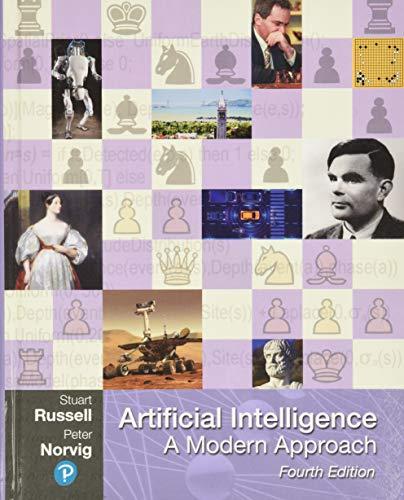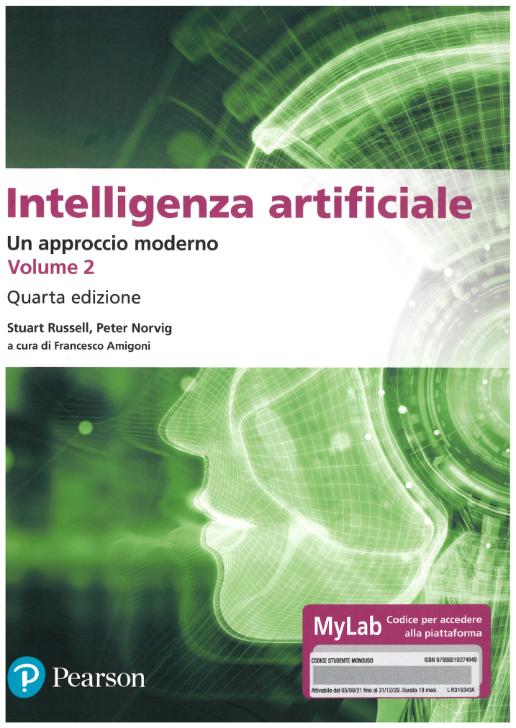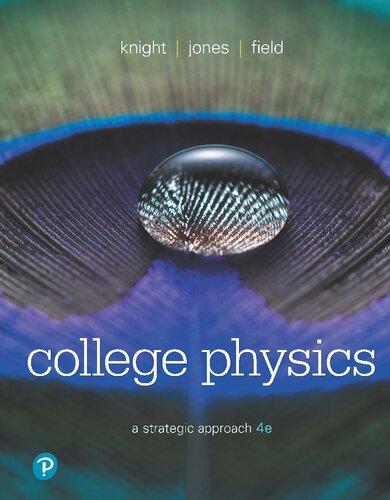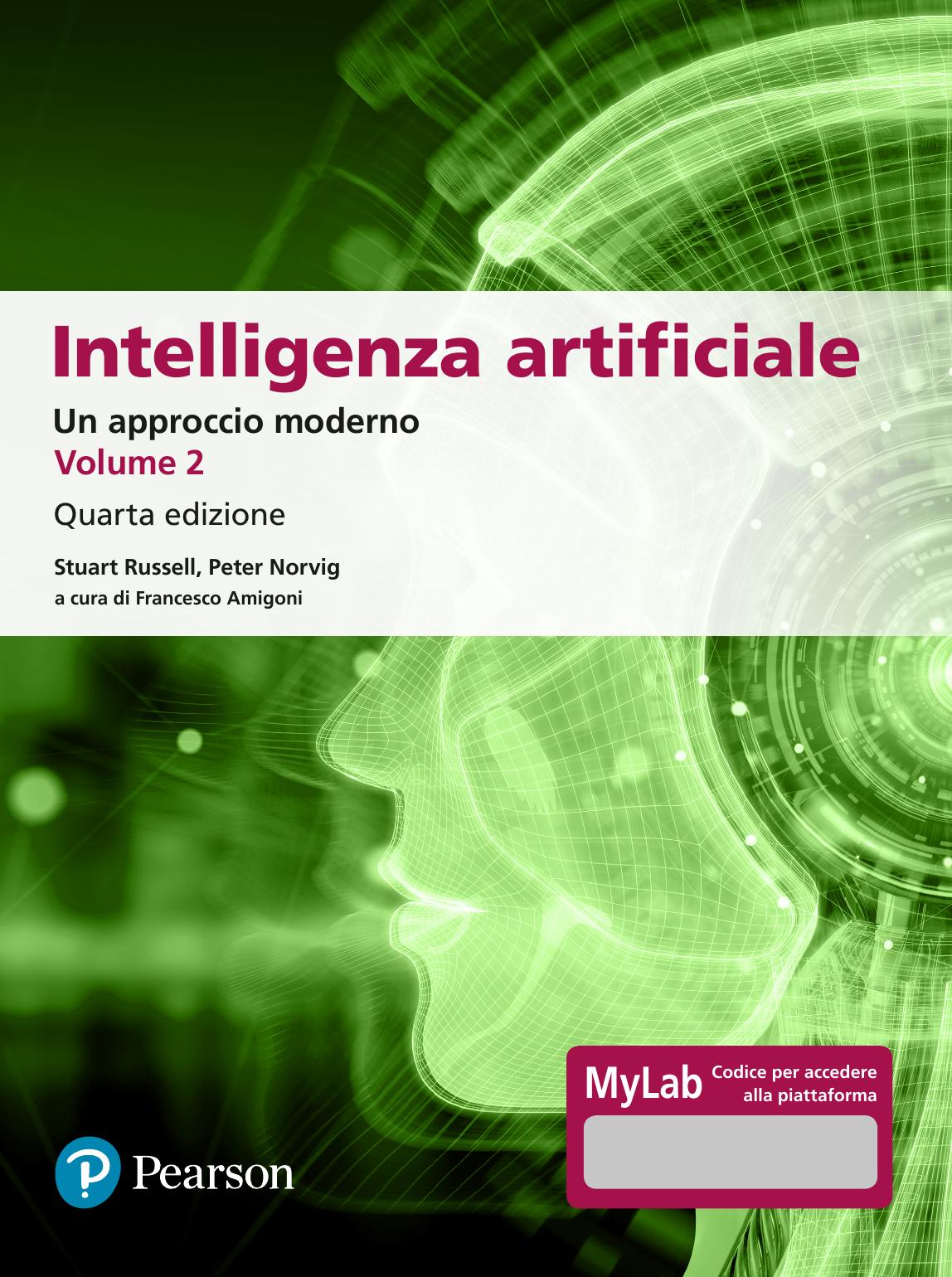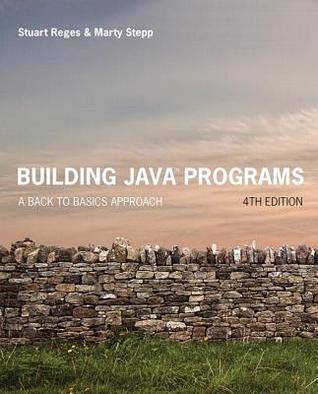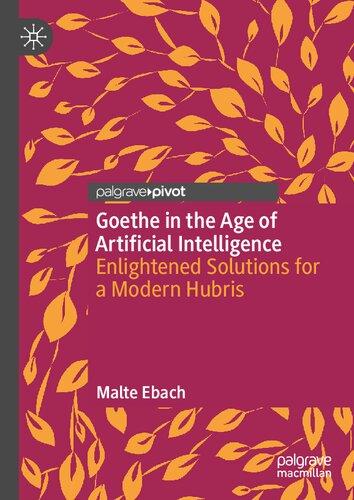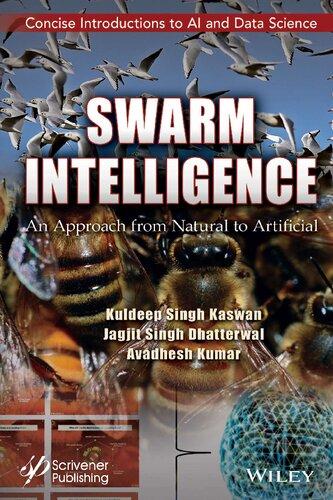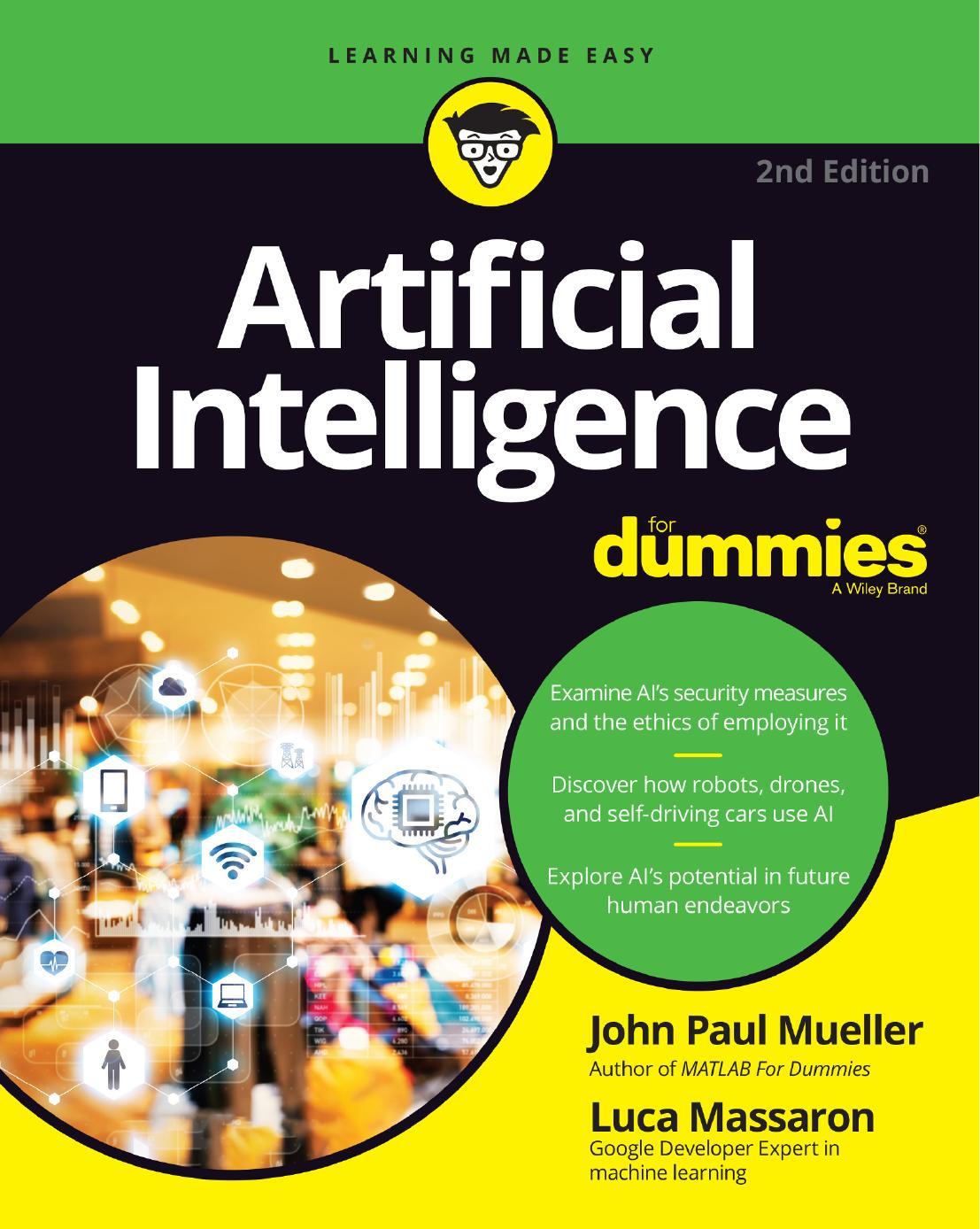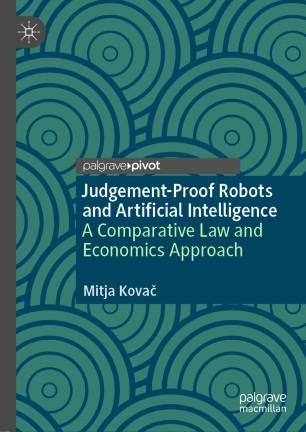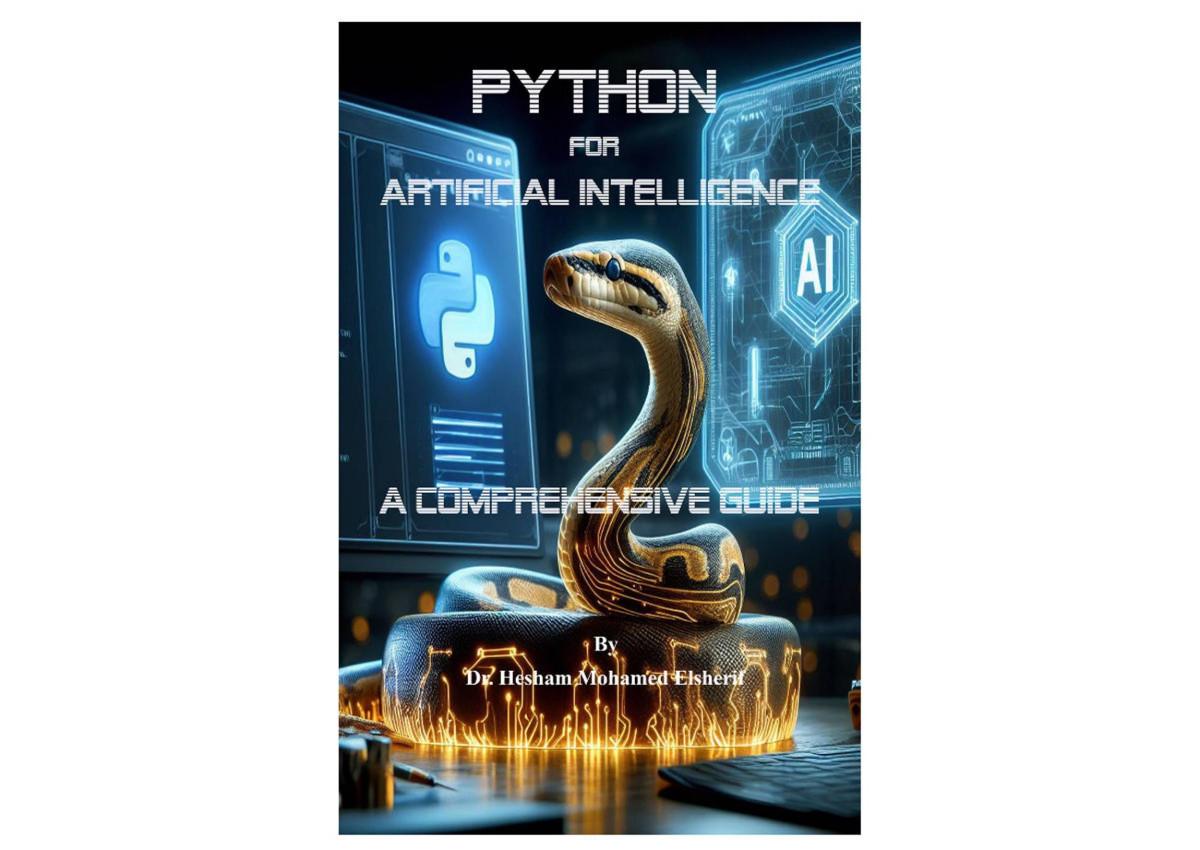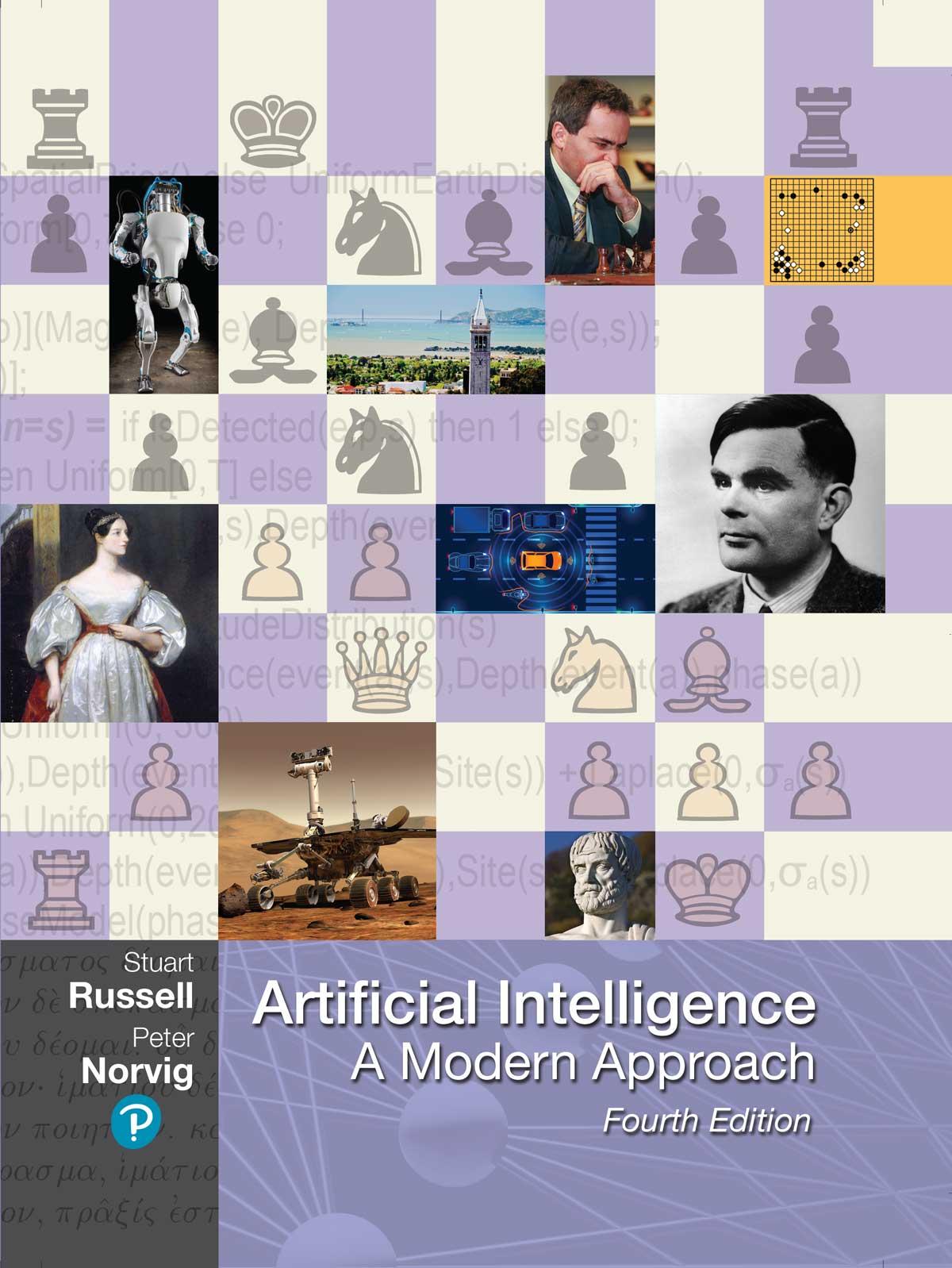Artificial Intelligence
A Modern Approach
Fourth Edition
Stuart J. Russell and Peter Norvig
Contributing writers:
Ming-Wei Chang
Jacob Devlin
Anca Dragan
David Forsyth
Ian Goodfellow
Jitendra M. Malik
Vikash Mansinghka
Judea Pearl
Michael Wooldridge
Copyright © 2021, 2010, 2003 by Pearson Education, Inc. or its affiliates, 221 River Street, Hoboken, NJ 07030. All Rights Reserved. Manufactured in the United States of America. This publication is protected by copyright, and permission should be obtained from the publisher prior to any prohibited reproduction, storage in a retrieval system, or transmission in any form or by any means, electronic, mechanical, photocopying, recording, or otherwise. For information regarding permissions, request forms, and the appropriate contacts within the Pearson Education Global Rights and Permissions department, please visit www.pearsoned.com/permissions/.
Acknowledgments of third-party content appear on the appropriate page within the text.
Cover Images:
Alan Turing – Science History Images/Alamy Stock Photo
Statue of Aristotle – Panos Karas/Shutterstock
Ada Lovelace – Pictorial Press Ltd/Alamy Stock Photo
Autonomous cars – Andrey Suslov/Shutterstock
Atlas Robot – Boston Dynamics, Inc.
Berkeley Campanile and Golden Gate Bridge – Ben Chu/Shutterstock
Background ghosted nodes – Eugene Sergeev/Alamy Stock Photo
Chess board with chess figure – Titania/Shutterstock
Mars Rover – Stocktrek Images, Inc./Alamy Stock Photo
Kasparov – KATHY WILLENS/AP Images
PEARSON, ALWAYS LEARNING is an exclusive trademark owned by Pearson Education, Inc. or its affiliates in the U.S. and/or other countries.
Unless otherwise indicated herein, any third-party trademarks, logos, or icons that may appear in this work are the property of their respective owners, and any references to thirdparty trademarks, logos, icons, or other trade dress are for demonstrative or descriptive purposes only. Such references are not intended to imply any sponsorship, endorsement, authorization, or promotion of Pearson’s products by the owners of such marks, or any relationship between the owner and Pearson Education, Inc., or its affiliates, authors, licensees, or distributors.
Library of Congress Cataloging-in-Publication Data
Names: Russell, Stuart J. (Stuart Jonathan), author. | Norvig, Peter, author.
Title: Artificial intelligence : a modern approach / Stuart J. Russell and Peter Norvig.
Description: Fourth edition. | Hoboken : Pearson, [2021] | Series: Pearson series in artificial intelligence | Includes bibliographical references and index. | Summary: “Updated edition of popular textbook on Artificial Intelligence.”— Provided by publisher.
Identifiers: LCCN 2019047498 | ISBN 9780134610993 (hardcover)
Subjects: LCSH: Artificial intelligence.
Classification: LCC Q335 .R86 2021 | DDC 006.3–dc23
LC record available at https://lccn.loc.gov/2019047498
ScoutAutomatedPrintCode
ISBN-10: 0-13-461099-7
ISBN-13: 978-0-13-461099-3
For Loy, Gordon, Lucy, George, and Isaac — S.J.R.
For Kris, Isabella, and Juliet — P.N.
Preface
Artificial Intelligence (AI) is a big field, and this is a big book. We have tried to explore the full breadth of the field, which encompasses logic, probability, and continuous mathematics; perception, reasoning, learning, and action; fairness, trust, social good, and safety; and applications that range from microelectronic devices to robotic planetary explorers to online services with billions of users.
The subtitle of this book is “A Modern Approach.” That means we have chosen to tell the story from a current perspective. We synthesize what is now known into a common framework, recasting early work using the ideas and terminology that are prevalent today. We apologize to those whose subfields are, as a result, less recognizable.
New to this edition
This edition reflects the changes in AI since the last edition in 2010:
We focus more on machine learning rather than hand-crafted knowledge engineering, due to the increased availability of data, computing resources, and new algorithms. Deep learning, probabilistic programming, and multiagent systems receive expanded coverage, each with their own chapter.
The coverage of natural language understanding, robotics, and computer vision has been revised to reflect the impact of deep learning.
The robotics chapter now includes robots that interact with humans and the application of reinforcement learning to robotics.
Previously we defined the goal of AI as creating systems that try to maximize expected utility, where the specific utility information—the objective—is supplied by the human designers of the system. Now we no longer assume that the objective is fixed and known by the AI system; instead, the system may be uncertain about the true objectives of the humans on whose behalf it operates. It must learn what to maximize and must function appropriately even while uncertain about the objective.
We increase coverage of the impact of AI on society, including the vital issues of ethics, fairness, trust, and safety.
We have moved the exercises from the end of each chapter to an online site. This allows us to continuously add to, update, and improve the exercises, to meet the needs of instructors and to reflect advances in the field and in AI-related software tools.
Overall, about 25% of the material in the book is brand new. The remaining 75% has been largely rewritten to present a more unified picture of the field. 22% of the citations in this edition are to works published after 2010.
Overview of the book
The main unifying theme is the idea of an intelligent agent. We define AI as the study of agents that receive percepts from the environment and perform actions. Each such agent implements a function that maps percept sequences to actions, and we cover different ways to represent these functions, such as reactive agents, real-time planners, decision-theoretic systems, and deep learning systems. We emphasize learning both as a construction method for competent systems and as a way of extending the reach of the designer into unknown environments. We treat robotics and vision not as independently defined problems, but as occurring in the service of achieving goals. We stress the importance of the task environment in determining the appropriate agent design.
Our primary aim is to convey the ideas that have emerged over the past seventy years of AI research and the past two millennia of related work. We have tried to avoid excessive formality in the presentation of these ideas, while retaining precision. We have included mathematical formulas and pseudocode algorithms to make the key ideas concrete; mathematical concepts and notation are described in Appendix A and our pseudocode is described in Appendix B .
This book is primarily intended for use in an undergraduate course or course sequence. The book has 28 chapters, each requiring about a week’s worth of lectures, so working through the whole book requires a two-semester sequence. A one-semester course can use selected chapters to suit the interests of the instructor and students. The book can also be used in a graduate-level course (perhaps with the addition of some of the primary sources suggested in the bibliographical notes), or for self-study or as a reference.
Throughout the book, important points are marked with a triangle icon in the margin. Wherever a new term is defined, it is also noted in the margin. Subsequent significant uses of the term are in bold, but not in the margin. We have included a comprehensive index and an extensive bibliography.
Term
The only prerequisite is familiarity with basic concepts of computer science (algorithms, data structures, complexity) at a sophomore level. Freshman calculus and linear algebra are useful for some of the topics.
Online resources
Online resources are available through pearsonhighered.com/cs-resources or at the book’s Web site, aima.cs.berkeley.edu. There you will find:
Exercises, programming projects, and research projects. These are no longer at the end of each chapter; they are online only. Within the book, we refer to an online exercise with a name like “Exercise 6.NARY.” Instructions on the Web site allow you to find exercises by name or by topic.
Implementations of the algorithms in the book in Python, Java, and other programming languages (currently hosted at github.com/aimacode).
A list of over 1400 schools that have used the book, many with links to online course materials and syllabi.
Supplementary material and links for students and instructors. Instructions on how to report errors in the book, in the likely event that some exist.
Book cover
The cover depicts the final position from the decisive game 6 of the 1997 chess match in which the program Deep Blue defeated Garry Kasparov (playing Black), making this the first
time a computer had beaten a world champion in a chess match. Kasparov is shown at the top. To his right is a pivotal position from the second game of the historic Go match between former world champion Lee Sedol and DeepMind’s ALPHAGO program. Move 37 by ALPHAGO violated centuries of Go orthodoxy and was immediately seen by human experts as an embarrassing mistake, but it turned out to be a winning move. At top left is an Atlas humanoid robot built by Boston Dynamics. A depiction of a self-driving car sensing its environment appears between Ada Lovelace, the world’s first computer programmer, and Alan Turing, whose fundamental work defined artificial intelligence. At the bottom of the chess board are a Mars Exploration Rover robot and a statue of Aristotle, who pioneered the study of logic; his planning algorithm from De Motu Animalium appears behind the authors’ names. Behind the chess board is a probabilistic programming model used by the UN Comprehensive Nuclear-Test-Ban Treaty Organization for detecting nuclear explosions from seismic signals.
Acknowledgments
It takes a global village to make a book. Over 600 people read parts of the book and made suggestions for improvement. The complete list is at aima.cs.berkeley.edu/ack.html; we are grateful to all of them. We have space here to mention only a few especially important contributors. First the contributing writers:
Judea Pearl (Section 13.5 , Causal Networks);
Vikash Mansinghka (Section 15.3 , Programs as Probability Models);
Michael Wooldridge (Chapter 18 , Multiagent Decision Making);
Ian Goodfellow (Chapter 21 , Deep Learning);
Jacob Devlin and Mei-Wing Chang (Chapter 24 , Deep Learning for Natural Language);
Jitendra Malik and David Forsyth (Chapter 25 , Computer Vision);
Anca Dragan (Chapter 26 , Robotics).
Then some key roles:
Cynthia Yeung and Malika Cantor (project management);
Julie Sussman and Tom Galloway (copyediting and writing suggestions);
Omari Stephens (illustrations); Tracy Johnson (editor); Erin Ault and Rose Kernan (cover and color conversion); Nalin Chhibber, Sam Goto, Raymond de Lacaze, Ravi Mohan, Ciaran O’Reilly, Amit Patel, Dragomir Radiv, and Samagra Sharma (online code development and mentoring); Google Summer of Code students (online code development).
Stuart would like to thank his wife, Loy Sheflott, for her endless patience and boundless wisdom. He hopes that Gordon, Lucy, George, and Isaac will soon be reading this book after they have forgiven him for working so long on it. RUGS (Russell’s Unusual Group of Students) have been unusually helpful, as always.
Peter would like to thank his parents (Torsten and Gerda) for getting him started, and his wife (Kris), children (Bella and Juliet), colleagues, boss, and friends for encouraging and tolerating him through the long hours of writing and rewriting.
About the Authors
STUART RUSSELL was born in 1962 in Portsmouth, England. He received his B.A. with first-class honours in physics from Oxford University in 1982, and his Ph.D. in computer science from Stanford in 1986. He then joined the faculty of the University of California at Berkeley, where he is a professor and former chair of computer science, director of the Center for Human-Compatible AI, and holder of the Smith–Zadeh Chair in Engineering. In 1990, he received the Presidential Young Investigator Award of the National Science Foundation, and in 1995 he was cowinner of the Computers and Thought Award. He is a Fellow of the American Association for Artificial Intelligence, the Association for Computing Machinery, and the American Association for the Advancement of Science, an Honorary Fellow of Wadham College, Oxford, and an Andrew Carnegie Fellow. He held the Chaire Blaise Pascal in Paris from 2012 to 2014. He has published over 300 papers on a wide range of topics in artificial intelligence. His other books include The Use of Knowledge in Analogy and Induction, Do the Right Thing: Studies in Limited Rationality (with Eric Wefald), and Human Compatible: Artificial Intelligence and the Problem of Control.
PETER NORVIG is currently a Director of Research at Google, Inc., and was previously the director responsible for the core Web search algorithms. He co-taught an online AI class that signed up 160,000 students, helping to kick off the current round of massive open online classes. He was head of the Computational Sciences Division at NASA Ames Research Center, overseeing research and development in artificial intelligence and robotics. He received a B.S. in applied mathematics from Brown University and a Ph.D. in computer science from Berkeley. He has been a professor at the University of Southern California and a faculty member at Berkeley and Stanford. He is a Fellow of the American Association for Artificial Intelligence, the Association for Computing Machinery, the American Academy of Arts and Sciences, and the California Academy of Science. His other books are Paradigms of AI Programming: Case Studies in Common Lisp, Verbmobil: A Translation System for Face-to-Face Dialog, and Intelligent Help Systems for UNIX.
The two authors shared the inaugural AAAI/EAAI Outstanding Educator award in 2016.
I Artificial Intelligence
1 Introduction 1
1.1 What Is AI? 1
1.2 The Foundations of Artificial Intelligence 5
1.3 The History of Artificial Intelligence 17
1.4 The State of the Art 27
1.5 Risks and Benefits of AI 31
Summary 34
Bibliographical and Historical Notes 35
2 Intelligent Agents 36
2.1 Agents and Environments 36
2.2 Good Behavior: The Concept of Rationality 39
2.3 The Nature of Environments 42
2.4 The Structure of Agents 47
Summary 60
Bibliographical and Historical Notes 60
II Problem-solving
3 Solving Problems by Searching 63
3.1 Problem-Solving Agents 63
3.2 Example Problems 66
3.3 Search Algorithms 71
3.4 Uninformed Search Strategies 76
3.5 Informed (Heuristic) Search Strategies 84
3.6 Heuristic Functions 97
Summary 104
Bibliographical and Historical Notes 106
4 Search in Complex Environments 110
4.1 Local Search and Optimization Problems 110
4.2 Local Search in Continuous Spaces 119
4.3 Search with Nondeterministic Actions 122
4.4 Search in Partially Observable Environments 126
4.5 Online Search Agents and Unknown Environments 134
Summary 141
Bibliographical and Historical Notes 142
5 Adversarial Search and Games 146
5.1 Game Theory 146
5.2 Optimal Decisions in Games 148
5.3 Heuristic Alpha–Beta Tree Search 156
5.4 Monte Carlo Tree Search 161
5.5 Stochastic Games 164
5.6 Partially Observable Games 168
5.7 Limitations of Game Search Algorithms 173
Summary 174
Bibliographical and Historical Notes 175
6 Constraint Satisfaction Problems 180
6.1 Defining Constraint Satisfaction Problems 180
6.2 Constraint Propagation: Inference in CSPs 185
6.3 Backtracking Search for CSPs 191
6.4 Local Search for CSPs 197
6.5 The Structure of Problems 199
Summary 203
Bibliographical and Historical Notes 204
III Knowledge, reasoning, and planning
7 Logical Agents 208
7.1 Knowledge-Based Agents 209
7.2 The Wumpus World 210
7.3 Logic 214
7.4 Propositional Logic: A Very Simple Logic 217
7.5 Propositional Theorem Proving 222
7.6 Effective Propositional Model Checking 232
7.7 Agents Based on Propositional Logic 237
Summary 246
Bibliographical and Historical Notes 247
8 First-Order Logic 251
8.1 Representation Revisited 251
8.2 Syntax and Semantics of First-Order Logic 256
8.3 Using First-Order Logic 265
8.4 Knowledge Engineering in First-Order Logic 271
Summary 277
Bibliographical and Historical Notes 278
9 Inference in First-Order Logic 280
9.1 Propositional vs. First-Order Inference 280
9.2 Unification and First-Order Inference 282
9.3 Forward Chaining 286
9.4 Backward Chaining 293
9.5 Resolution 298
Summary 309
Bibliographical and Historical Notes 310
10 Knowledge Representation 314
10.1 Ontological Engineering 314
10.2 Categories and Objects 317
10.3 Events 322
10.4 Mental Objects and Modal Logic 326
10.5 Reasoning Systems for Categories 329
10.6 Reasoning with Default Information 333
Summary 337
Bibliographical and Historical Notes 338
11 Automated Planning 344
11.1 Definition of Classical Planning 344
11.2 Algorithms for Classical Planning 348
11.3 Heuristics for Planning 353
11.4 Hierarchical Planning 356
11.5 Planning and Acting in Nondeterministic Domains 365
11.6 Time, Schedules, and Resources 374
11.7 Analysis of Planning Approaches 378
Summary 379
Bibliographical and Historical Notes 380
IV Uncertain knowledge and reasoning
12 Quantifying Uncertainty 385
12.1 Acting under Uncertainty 385
12.2 Basic Probability Notation 388
12.3 Inference Using Full Joint Distributions 395
12.4 Independence 397
12.5 Bayes’ Rule and Its Use 399
12.6 Naive Bayes Models 402
12.7 The Wumpus World Revisited 404
Summary 407
Bibliographical and Historical Notes 408
13
Probabilistic Reasoning 412
13.1 Representing Knowledge in an Uncertain Domain 412
13.2 The Semantics of Bayesian Networks 414
13.3 Exact Inference in Bayesian Networks 427
13.4 Approximate Inference for Bayesian Networks 435
13.5 Causal Networks 449
Summary 453
Bibliographical and Historical Notes 454
14 Probabilistic Reasoning over Time 461
14.1 Time and Uncertainty 461
14.2 Inference in Temporal Models 465
14.3 Hidden Markov Models 473
14.4 Kalman Filters 479
14.5 Dynamic Bayesian Networks 485
Summary 496
Bibliographical and Historical Notes 497
15 Probabilistic Programming 500
15.1 Relational Probability Models 501
15.2 Open-Universe Probability Models 507
15.3 Keeping Track of a Complex World 514
15.4 Programs as Probability Models 519
Summary 523
Bibliographical and Historical Notes 524
16 Making Simple Decisions 528
16.1 Combining Beliefs and Desires under Uncertainty 528
16.2 The Basis of Utility Theory 529
16.3 Utility Functions 532
16.4 Multiattribute Utility Functions 540
16.5 Decision Networks 544
16.6 The Value of Information 547
16.7 Unknown Preferences 553
Summary 557
Bibliographical and Historical Notes 557
17 Making Complex Decisions 562
17.1 Sequential Decision Problems 562
17.2 Algorithms for MDPs 572
17.3 Bandit Problems 581
17.4 Partially Observable MDPs 588
17.5 Algorithms for Solving POMDPs 590
Summary 595
Bibliographical and Historical Notes 596
18 Multiagent Decision Making 599
18.1 Properties of Multiagent Environments 599
18.2 Non-Cooperative Game Theory 605
18.3 Cooperative Game Theory 626
18.4 Making Collective Decisions 632
Summary 645
Bibliographical and Historical Notes 646
V Machine Learning
19 Learning from Examples 651
19.1 Forms of Learning 651
19.2 Supervised Learning 653
19.3 Learning Decision Trees 657
19.4 Model Selection and Optimization 665
19.5 The Theory of Learning 672
19.6 Linear Regression and Classification 676
19.7 Nonparametric Models 686
19.8 Ensemble Learning 696
19.9 Developing Machine Learning Systems 704
Summary 714
Bibliographical and Historical Notes 715
20 Learning Probabilistic Models 721
20.1 Statistical Learning 721
20.2 Learning with Complete Data 724
20.3 Learning with Hidden Variables: The EM Algorithm 737
Summary 746
Bibliographical and Historical Notes 747
21 Deep Learning 750
21.1 Simple Feedforward Networks 751
21.2 Computation Graphs for Deep Learning 756
21.3 Convolutional Networks 760
21.4 Learning Algorithms 765
21.5 Generalization 768
21.6 Recurrent Neural Networks 772
21.7 Unsupervised Learning and Transfer Learning 775
21.8 Applications 782
Summary 784
Bibliographical and Historical Notes 785
22 Reinforcement Learning 789
22.1 Learning from Rewards 789
22.2 Passive Reinforcement Learning 791
22.3 Active Reinforcement Learning 797
22.4 Generalization in Reinforcement Learning 803
22.5 Policy Search 810
22.6 Apprenticeship and Inverse Reinforcement Learning 812
22.7 Applications of Reinforcement Learning 815
Summary 818
Bibliographical and Historical Notes 819
VI Communicating, perceiving, and acting
23 Natural Language Processing 823
23.1 Language Models 823
23.2 Grammar 833
23.3 Parsing 835
23.4 Augmented Grammars 841
23.5 Complications of Real Natural Language 845
23.6 Natural Language Tasks 849
Summary 850
Bibliographical and Historical Notes 851
24 Deep Learning for Natural Language Processing 856
24.1 Word Embeddings 856
24.2 Recurrent Neural Networks for NLP 860
24.3 Sequence-to-Sequence Models 864
24.4 The Transformer Architecture 868
24.5 Pretraining and Transfer Learning 871
24.6 State of the art 875
Summary 878
Bibliographical and Historical Notes 878
25 Computer Vision 881
25.1 Introduction 881
25.2 Image Formation 882
25.3 Simple Image Features 888
25.4 Classifying Images 895
25.5 Detecting Objects 899
25.6 The 3D World 901
25.7 Using Computer Vision 906
Summary 919
Bibliographical and Historical Notes 920
26 Robotics 925
26.1 Robots 925
26.2 Robot Hardware 926
26.3 What kind of problem is robotics solving? 930
26.4 Robotic Perception 931
26.5 Planning and Control 938
26.6 Planning Uncertain Movements 956
26.7 Reinforcement Learning in Robotics 958
26.8 Humans and Robots 961
26.9 Alternative Robotic Frameworks 968
26.10 Application Domains 971
Summary 974
Bibliographical and Historical Notes 975
VII Conclusions
27 Philosophy, Ethics, and Safety of AI 981
27.1 The Limits of AI 981
27.2 Can Machines Really Think? 984
27.3 The Ethics of AI 986
Summary 1005
Bibliographical and Historical Notes 1006
28 The Future of AI 1012
28.1 AI Components 1012
28.2 AI Architectures 1018
A Mathematical Background 1023
A.1 Complexity Analysis and O() Notation 1023
A.2 Vectors, Matrices, and Linear Algebra 1025
A.3 Probability Distributions 1027
Bibliographical and Historical Notes 1029
B Notes on Languages and Algorithms 1030
B.1 Defining Languages with Backus–Naur Form (BNF) 1030
B.2 Describing Algorithms with Pseudocode 1031
B.3 Online Supplemental Material 1032
Bibliography 1033
Index 1069
